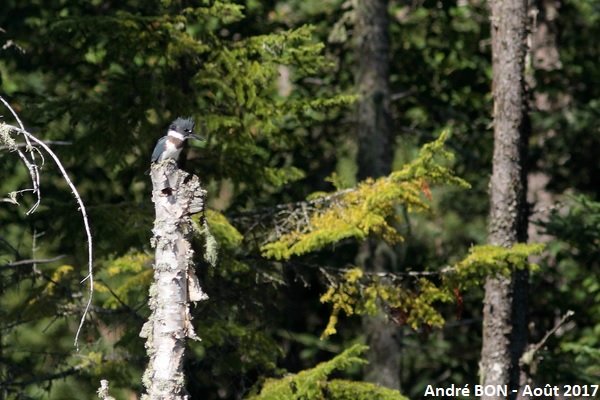
| Belted Kingfisher (Megacelyle alcyon (Linnaeus, 1758)) |

|
|
Scientific name: Megacelyle alcyon (Linnaeus, 1758) Common name: Belted Kingfisher French name: Martin-pêcheur d'Amérique Order: Coraciiformes Family: Alcedinidae Size: Body size: 28 to 33 cm; Weight: 115 to 175 g; Wingspan: 48 to 58 cm. Habitat: Various aquatic habitats, lakes, ponds, streams, creeks, mangroves, with high perches to detect prey. Food: Mainly fishes. When these are lacking, it can consume crustaceans, amphibians, reptiles and aquatic insects. Nesting: The nest is a tunnel about 80 cm long dug by the pair. The clutch consists of 6 to 7 eggs. Migration: Partial migrant. Some individuals winter in Central America, the Antilles, Colombia or Venezuela. Geographic area: North America. |
The top of the Belted Kingfisher's head bears a large blue-grey crest that extends from the base of the beak to the nape. The sides of the neck, throat and belly are white. A wide blue-grey V-shaped band separates the throat from the belly. The back is blue-grey. The short grey tail is barred with white. Females are more colourful than males. They bear a russet stripe below the blue-grey band on the chest and some russet spots on the flanks. |
| [To know more about the Belted Kingfisher] [Top] |

|
We observed this Belted Kingfisher while canoeing on Pal Lake. It was not really possible to approach it and this photo is an important crop. The high trees bordering the lake are ideal perches for staying in wait for prey. By zooming in on the unreduced photo we can see a little redness under the chest band and on the flanks. So we most likely have a female here. |